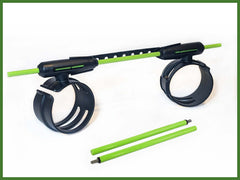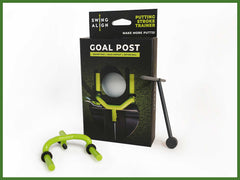Keeping Your Left Arm & Elbow Straight in a Golf Swing
Every part of the body has to be insync for a golf swing to work, but the role of the left arm in golf swing is one of the most crucial and easy to check components. This article will discuss proper positioning for your left arm in a golf swing, when to think about it, and how it should move throughout your swing. An important note, this page will discuss the importance of the left arm in the golf swing as most golfers are right-handed, but what we really mean is the lead arm in the golf swing. So if you’re a left-handed player, this article will be about your right arm.
Why Keep Your Left Arm Straight?
Although it isn’t the dominant arm for right-handed players, the left arm is vital to the golf swing. It largely determines the spacing and arc of your golf swing, it helps control the clubface and ensures power through impact. Too much bend in your left arm can throw off the timing of the rest of your body, costing you power and making it more difficult to square the club at impact and start the ball on-line.
During your swing, you don’t need to feel as though your left arm is rigidly locked into place, but it needs to be relatively straight. This starts with the left elbow, as it is the hinge in your arm that controls its bend throughout the golf swing. The left elbow should be kept as straight as possible during the golf swing before hinging after impact in your follow-through.
Proper Left Arm Positioning
There are several key positions worth noting — takeaway, left arm parallel to the ground, the top of your backswing, downswing, and impact — that you can focus on to keep your left arm straight through your golf swing.
First, as you start your backswing, keep your left arm straight and close to your body until it approaches parallel to the ground and your wrists start to hinge. You’ll want to make sure that your arms and body are “connected” and your body is driving your turn away from the ball, not your arms. Remember that golf is a rotational game and body rotation creates speed and power. Your arms, particularly your lead arm goes along for the ride.

Some golfers struggle to keep their left arm straight during the takeaway. A good thought is to push your left arm away from the ball by rotating your shoulders and trunk with your left shoulder working down and under your chin. If you are using a Swing Align device the front of the rod will move down first (not out and around). This will help you keep your left arm straight and close to your body which starts your takeaway on the proper swing plane.
When your left arm is parallel to the ground, your left and right arms should be essentially level. It is ok if your left arm is slightly under your right arm as this helps you stay on the proper swing plane. If your left arm and shoulder are higher than your right, your club will move too far to the inside increasing your chance of coming over the top on the way down and hitting a weak slice.
Next, at the top of your swing check to see that you have kept your left arm straight. An extended left arm will create a large arc in your golf swing and help you make a powerful move into the ball. If you find your left arm is bending at the top of your swing it is most likely because your body has stopped rotating and you are trying to generate more reach and power with your arms. This only serves to make it harder for you to make a well timed and connected swing down to the ball. The length of your swing is dictated by how much you can rotate, not how far you can swing your arms. If you feel your swing is too short try rotating your lower body more. This gives you additional room to turn your upper body while keeping your left arm straight in your golf swing.

On the downswing, the left arm remains relatively straight. A little bend here is ok but the goal is to maintain your width. As you approach impact it is ok if the left arm is a little higher than the right (or trail) arm. On the way down your trail arm and elbow should be close to the body showing that you are delivering the club from an inside to square position for power and control. Note the difference of the arm and alignment rod positions in the following pictures.

Finally, and perhaps most importantly, your left arm should be as straight as possible at impact. Bend in your left arm at impact means that you are holding onto the club, preventing a full release that maintains your club speed. Bending your left arm at impact is commonly referred to as the dreaded chicken wing. This decreases the amount of force you can put into the ball as your arms are not fully extended and swinging freely. Concentrate on keeping your left arm straight and close to your body at impact, just like you did on the takeaway.
OK To Bend Your Left Elbow On the Follow Through
After impact, your arms and body should release towards the target and fully extend through the golf ball. The ball has already been hit but by keeping your arms straight and getting full extension you create good habits and speed in your golf swing. It also teaches you to make a full swing instead of decelerating at impact.

During the follow through your left arm will remain straight after hitting the ball, but will bend as you rotate through to face your target and your arms come up to your finishing position. Maintaining rotation is important because it helps get your right shoulder down and through the ball, driving your arms through impact. You want your left arm to bend at the end while your right arm remains relatively straight.
Practice Your Left Arm Positioning with Swing Align
Many golfers struggle keeping their left arm straight through the golf swing. It takes a lot of practice to feel comfortable in each position, ensuring that you are doing everything you can to let your left arm work for you. The Swing Align trainer is the perfect tool to help you gain confidence in those positions. Swing Align provides direct feedback on your golf swing, providing you with a visual aid on your performance. It also allows you to feel when you are in the proper positions and when you aren’t. Let’s look at some examples.
With the Swing Align tool attached, you will instantly understand the importance of the connection between your arms and the rest of your upper body. Swing Align teaches you how to stay connected and helps get that left arm into the proper positions during the takeaway, top of the swing, and at impact. Start by taking some small swings, rotating back only so that your left arm is parallel to the ground. Keep your left arm close to your body and rotate the alignment rod back and through using your body.
Once you feel comfortable with your takeaway, practice taking the club to the top of your backswing while keeping the left arm straight. The Swing Align rod should be perpendicular to the target line at the top and level or pointing slightly down. If you bend your left arm at this position, you will notice the Swing Align rod is not in the correct position.
Use Swing Align for the Perfect Left Arm Position!
There are many tools in the marketplace that claim to help with your left arm positioning, but Swing Align is the only product that allows you to see and feel every position in your golf swing. It allows you to feel the proper connection between your left arm and your upper body during the takeaway and follow through. Remember that body rotation is critical to maintaining a straight left arm and Swing Align helps you see how much you turn. Visit Swing Align’s full collection of products to drop strokes off your game and achieve proper positioning throughout your golf swing!
















